Media Effects Research Lab - Research Archive
Examining psychological effects of heuristic cues on users’ attitudes on a product review website
Student Researcher(s)
Hyang Sook Kim (Ph.D Candidate);
Pamela Brubaker (Ph.D Candidate);
Andrew Kegerise (Ph.D Candidate);
Kiwon Seo (Ph.D Candidate);
Faculty Supervisor
INTRODUCTION
Reliance on product review websites for helping consumers make purchasing decisions is becoming ever more prevalent. Previous literature suggests that design features like source attributions (e.g., ratings from an editor, other users, or website) and visual signals that indicate quality rating (e.g., star ratings) can exert effects on attitude formation among those consumers (e.g., Chen & Xie, 2008; Chevalier & Mayzlin, 2006). In addition, a set of icons that allows website users to share information is also a common feature available in the product review websites. However, evidence of the effect of such a sharing application is quite primitive. Based on Sundar’s MAIN model (2008), this study is to explore the underlying mechanisms guiding psychological effects of various technological features found on online product review websites.
RESEARCH QUESTIONS / HYPOTHESES:
H1: Website users will show more favorable attitude toward a product/website when they perceive a computer/system as the source of product review information than when they perceive an expert (e.g., editor) as the source.
H2: Website users will show more favorable attitudes toward a product/website when they perceive other users as the source of product review information than when perceiving an expert (e.g., editor) as the source.
RQ1. Will the source, other users or the computer/system itself exhibit a more powerful influence on the decision-making processes users make on product review websites?
RQ2. Do the visual cues of both star ratings and source attribution interact with each other in relation to the decision-making processes that occur on product review websites?
H3. Participants that read a product review with the presence of sharing applications will show a greater intention to share product review information when the information is attributed to an expert opposed to a website.
H4. Participants who noticed the availability of sharing applications on a product review website will have a greater intention to share product review information when the information is attributed to other people instead of a website.
H5. Sense of agency will mediate the relationship between presence of sharing applications and sharing intention.
H6.Credibility will mediate the relationship between the authority, machine, bandwagon or identity heuristics and their influence on users’ judgment of product reviews and the website.
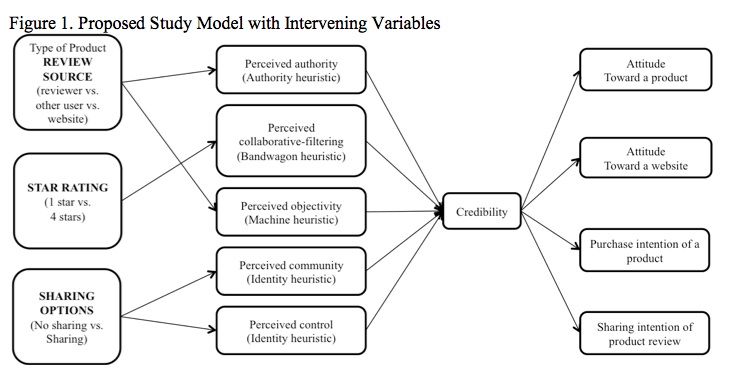
METHOD
Research questions were explored using a 2 (star rating: 4 stars vs. 1 star) × 3 (source information: expert reviewer’s vs. other users’ vs. website rating) × 2 (sharing options: presence vs. absence) between-participants online experiment. Four hundred seventy-eight undergraduate students were exposed to identical product reviews for a haptic cell phone, with variations in rating cues, source cues, and sharing options after completion of an online consent form and pre-questionnaire including their familiarity with product review websites as well as haptic cell phones.
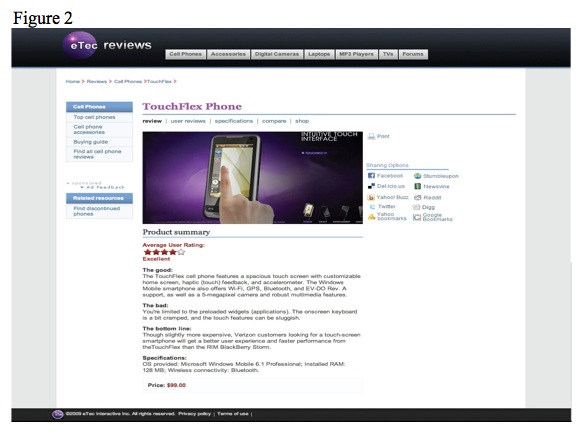
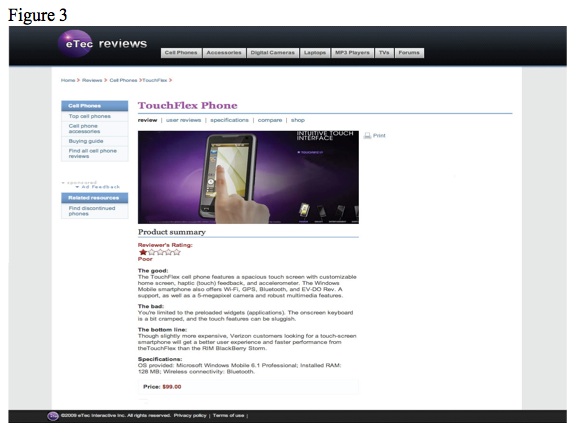
When they finished reviewing the screenshot of the webpage, they were asked to proceed with the remainder of the questionnaire including measures of product/webpage attitudes, purchase/sharing intentions, perceived authority/bandwagon/objectiveness, sense of control and community, perceived credibility of product review, and task involvement. At this time participants were directed not to go back and examine the review.
RESULTS
The findings from the present study indicate that source will affect users’ decision-making processes through perceptions of heuristics on a product review website. In particular, an expert source of the review information exhibited the greater effect on participants’ attitudes toward the website than other user as source. Furthermore, star ratings as a value-laden cue also clearly showed their positive effects on not only users’ attitudes toward the product and website but also their purchase intention. Meanwhile, presence of sharing applications as an additional heuristic cue also showed a positive effect on users’ attitudes toward the product.
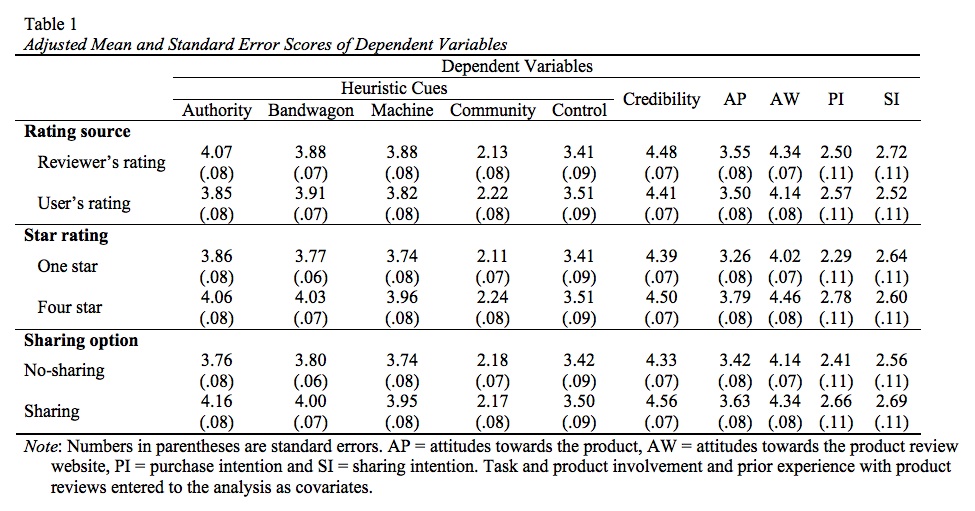
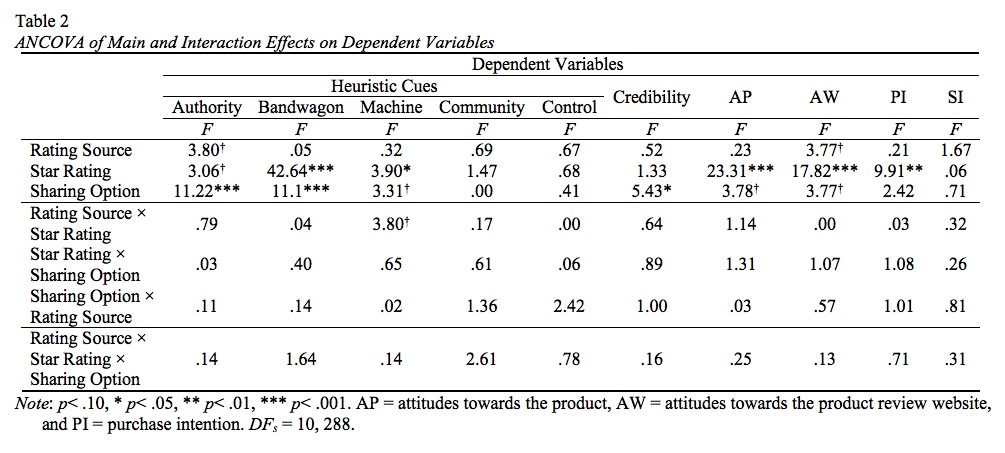
Two perceived heuristics – authority and bandwagon- played significant roles to conjunction between interface cues of reviewers, sharing applications and star ratings. Neither source nor value-laden cues resulted in the mediating effect of perception of heuristics and credibility on the judgment process.
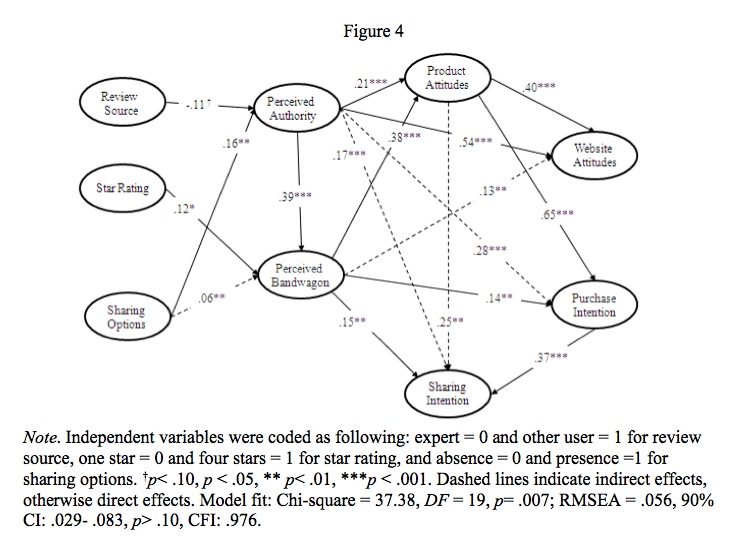
DISCUSSION/ CONCLUSION
The current study showed that presence of sharing options not only contributed to building credibility toward the review website but also lead to more favorable product attitudes. The findings also demonstrated that the simple presence of sharing affordances leads to increases in perceptions of authority and bandwagon heuristics. The possibility of sharing the product review could lead participants to infer the information is credible and thereby render the website authority. The presence of sharing options may have played the role of a ‘seal,’ which induced perceptions of authority on the website (Sundar, Xu, & Oeldorf-Hirsch, 2009). In addition, the presence of sharing options lead to increased bandwagon perceptions, suggesting this affordance cues perceptions of endorsement from others or social assessments of product quality.
The present study also suggests that people largely make decisions about product quality depending on the number of rating stars received on a review website. Bandwagon perceptions mediated the relationship between star rating and product and web page attitudes, and purchase intent. Because participants believed that the number of stars was a visual cue indicating aggregation of product reviews regardless of review source, they could perceive bandwagon power from the star ratings.
For more details regarding the study contact
Dr. S. Shyam Sundar by e-mail at sss12@psu.edu or by telephone at (814) 865-2173

